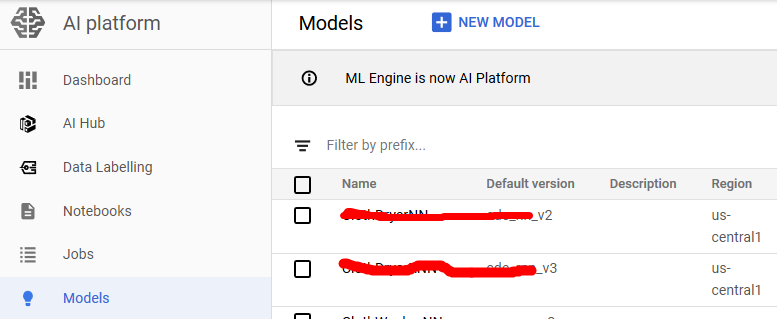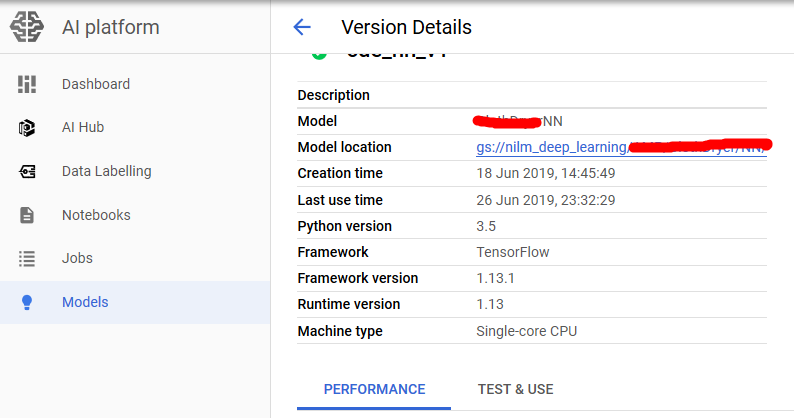Run Your Tensorflow Deep Learning Models on Google AI
People commonly tend to put much effort on hyperparameter tuning and training while using Tensoflow&Deep Learning. A realistic problem for TF is how to integrate models into industry: saving pre-trained models, restoring them when necessary, and doing predictions regarding to request input. Fortunately, Google AI helps!
Actually, while a model is trained, tensorflow has two different modes to save it. Most people and blog posts adopt Checkpoint, which refers to 'Training Mode'. The training work continues if someone load the checkpoint. But a drawback is you have to define the architecture once and once again before restore the checkpoint. Another mode called 'SavedModel' is more suitable for serving (release version product). Applications can send prediction requests to a server where the 'SavedModel' is deployed, and then responses will be sent back.
Before that, we only need to follow three steps: save the model properly, deploy it onto Google AI, transform data to required format then request. I am going to illustrate them one by one.
1. Save the model into SavedModel:
In a typical tensorflow training work, architecture is defined first, then it is trained, finally comes to saving part. We just jump to the saving code: the function used here is 'simple_save', and four parameters are session, saving folder, input variable&name, output variable&name.
tf.saved_model.simple_save(sess, 'simple_save/model', \
inputs={"x": tf_x},outputs={"pred": pred})
After that, we got the saved model on the target directory:
saved_model.pb
/variables/variables.index
/variables/variables.data-00000-of-00001
2. Deploy SavedModel onto Google AI:
On Google Cloud, files are stored on Google Bucket, so first a Tensorflow model (.pb file and variables folder) need to be uploaded. Then create a Google AI model and a version. Actually there can be multiple versions under a model, which is quite like solving one task by different ways. You can even use several deep learning architectures as
different version, and then switch solutions when request predictions. Versions and Google Bucket location that stores the SavedModel are bound.


3. Doing online predictions:
Because we request prediction inside the application, and require immediate response, so we choose online prediction. The official code to request is shown below, which is HTTP Request and HTTP Response. The input and output data are all in Json Format. We can transform our input data into List, and call this function.
def predict_json(project, model, instances, version=None):
"""Send json data to a deployed model for prediction. Args:
project (str): project where the AI Platform Model is deployed.
model (str): model name.
instances ([Mapping[str: Any]]): Keys should be the names of Tensors
your deployed model expects as inputs. Values should be datatypes
convertible to Tensors, or (potentially nested) lists of datatypes
convertible to tensors.
version: str, version of the model to target.
Returns:
Mapping[str: any]: dictionary of prediction results defined by the
model.
"""
# Create the AI Platform service object.
# To authenticate set the environment variable
# GOOGLE_APPLICATION_CREDENTIALS=<path_to_service_account_file>
service = googleapiclient.discovery.build('ml', 'v1')
name = 'projects/{}/models/{}'.format(project, model) if version is not None:
name += '/versions/{}'.format(version) response = service.projects().predict(
name=name,
body={'instances': instances}
).execute() if 'error' in response:
raise RuntimeError(response['error']) return response['predictions']
The response is also in Json format, I wrote a piece of code to transform it into Numpy Array:
def from_json_to_array(dict_list):
value_list = []
for dict_instance in dict_list:
instance = dict_instance.get('pred')
value_list.append(instance)
value_array = np.asarray(value_list)
return value_array
Yeah, that's it! Let's get your hands dirty!
Reference:
https://www.tensorflow.org/guide/saved_model
https://cloud.google.com/blog/products/ai-machine-learning/simplifying-ml-predictions-with-google-cloud-functions
https://cloud.google.com/ml-engine/docs/tensorflow/online-predict
Run Your Tensorflow Deep Learning Models on Google AI的更多相关文章
- How to Grid Search Hyperparameters for Deep Learning Models in Python With Keras
Hyperparameter optimization is a big part of deep learning. The reason is that neural networks are n ...
- a Javascript library for training Deep Learning models
w强化算法和数学,来迎接机器学习.神经网络. http://cs.stanford.edu/people/karpathy/convnetjs/ ConvNetJS is a Javascript l ...
- Towards Deep Learning Models Resistant to Adversarial Attacks
目录 概 主要内容 Note Madry A, Makelov A, Schmidt L, et al. Towards Deep Learning Models Resistant to Adver ...
- (转) Awesome Deep Learning
Awesome Deep Learning Table of Contents Free Online Books Courses Videos and Lectures Papers Tutori ...
- What are some good books/papers for learning deep learning?
What's the most effective way to get started with deep learning? 29 Answers Yoshua Bengio, ...
- (转) Deep Learning Resources
转自:http://www.jeremydjacksonphd.com/category/deep-learning/ Deep Learning Resources Posted on May 13 ...
- Machine and Deep Learning with Python
Machine and Deep Learning with Python Education Tutorials and courses Supervised learning superstiti ...
- The Brain vs Deep Learning Part I: Computational Complexity — Or Why the Singularity Is Nowhere Near
The Brain vs Deep Learning Part I: Computational Complexity — Or Why the Singularity Is Nowhere Near ...
- Coursera Deep Learning 2 Improving Deep Neural Networks: Hyperparameter tuning, Regularization and Optimization - week1, Assignment(Regularization)
声明:所有内容来自coursera,作为个人学习笔记记录在这里. Regularization Welcome to the second assignment of this week. Deep ...
随机推荐
- wepy_two
2.代码高亮WebStorm/PhpStorm(其他工具参见:wepy官网代码高亮) (1)打开Settings,搜索Plugins,搜索Vue.js插件并安装. (2) 打开Settings,搜索F ...
- SQLyog安装
安装 使用 首先看到下面的界面
- 查询sql server占用内存的情况
se master go select * from sysperfinfo where counter_name like '%Total Server Memory (KB)%' go
- 基于TMS320C6678、FPGA XC5VLX110T的6U CPCI 8路光纤信号处理卡
基于TMS320C6678.FPGA XC5VLX110T的6U CPCI 8路光纤信号处理卡 1.板卡概述 本板卡由我公司自主研发,基于CPCI架构,符合CPCI2.0标准,采用两片TI DSP T ...
- ARM Cortex-M底层技术(2)—启动代码详解
杂谈 工作了一天,脑袋比较乱.一直想把底层的知识写成一个系列,希望可以坚持下去.为什么要写底层的东西呢?首先,工作用到了这部分内容,最近和内部Flash打交道比较多,自然而然会接触到一些底层的东西:第 ...
- glob & fnmatch -- 使用Unix style通配符
通配符: ? 匹配单个字符 * 匹配 0+ 个字符 [seq] 匹配属于区间的单个字符 [!seq] 匹配不属于区间的单个字符 注意: "." just a " ...
- 采集容器内存并写到excel
# coding=utf-8 import os import commands import re from pyExcelerator import * def execute(cmd): sta ...
- git Octotree:提供项目目录,方便用户在线快速浏览项目结构【转载】
很好奇的是,GitHub 作为代码托管平台,竟然没有提供项目目录,方便用户在线快速浏览项目结构.所以,在线分析项目源码就会变得很繁琐,必须一层一层点击,然后再一次一次地向上返回.要知道,本来 GitH ...
- wannafly25 E 01串
链接 wannafly25 E 01串 给出一个\(01\)串,有两种操作,操作一是将某一个位置的数字修改,操作二是询问某一个区间,将这个区间看做\(1\)个二进制数,可以随意加减\(2\)的幂次,问 ...
- 左右flex布局
修复版本
